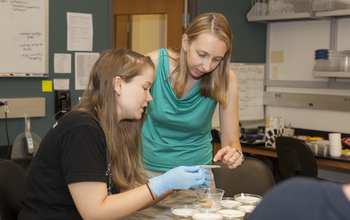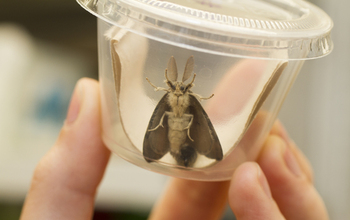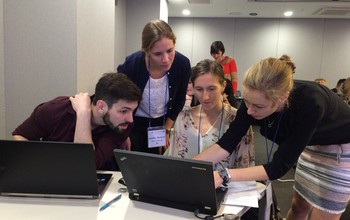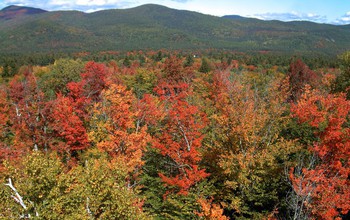All Images
News Release 17-076
10 new awards support ecological research at regional to continental scales
MacroSystems Biology and Early NEON Science projects use big data from NSF observatories, long-term research sites, federal agencies, citizen science data sets and other sources
This material is available primarily for archival purposes. Telephone numbers or other contact information may be out of date; please see current contact information at media contacts.

University of Oklahoma ecologist Michael Kaspari samples the ants from a plot at the Ordway Swisher NEON site. These samples, combined with the insects collected from pitfall trap network across NEON,will be used to greatly expand NEON's invertebrate data-reach, toward testing how the diversity, abundance, and activity of soil invertebrates varies with changing temperature, precipitation, and soil chemistry.
Credit: Michael Kaspari, University of Oklahoma. Photograph by Deborah Kaspari.
Download the high-resolution JPG version of the image. (7.7 MB)
Use your mouse to right-click (Mac users may need to Ctrl-click) the link above and choose the option that will save the file or target to your computer.

The University of Richmond's Kristine Grayson in her lab working with students. Grayson's work focuses on gypsy moths and climate.
Credit: University of Richmond, Gordon Schmidt
Download the high-resolution JPG version of the image. (9.5 MB)
Use your mouse to right-click (Mac users may need to Ctrl-click) the link above and choose the option that will save the file or target to your computer.

The gypsy moth can provide scientists insight on how changing environments affect the spread of invasive species.
Credit: University of Richmond, Gordon Schmidt
Download the high-resolution JPG version of the image. (9.0 MB)
Use your mouse to right-click (Mac users may need to Ctrl-click) the link above and choose the option that will save the file or target to your computer.

Awardee Cayelan Carey (far right) teaches students how to run lake models on their computers at a GLEON (Global Lake Ecological Observatory Network) workshop. Her new NSF award will support the development of modules that will teach undergraduate students macrosystems ecology concepts, quantitative reasoning skills, and computer programming.
Credit: Grace S. Hong
Download the high-resolution JPG version of the image. (1.1 MB)
Use your mouse to right-click (Mac users may need to Ctrl-click) the link above and choose the option that will save the file or target to your computer.

Work by awardee Andrew Richardson, of Northern Arizona University will use images from PhenoCam, a network of digital cameras, to track vegetation phenology at high spatial and temporal resolution across North America, from tundra to the tropics.
Credit: Images provided courtesy of the PhenoCam network
Download the high-resolution JPEG version of the image. (1.3 MB)
Use your mouse to right-click (Mac users may need to Ctrl-click) the link above and choose the option that will save the file or target to your computer.
_f_4897d16b-3bb5-4a51-beae-ba17eae6285e.jpg)
Appalachian State University's Jessica Mitchell will test biodiversity mapping methods using
reflectance spectroscopy (top) and laser scanning (bottom) technologies onboard the NSF-supported
National Ecology Observatory Network (NEON) Airborne Observation Platform. Scaling implications
will be investigated by combining NEON airborne and field based datasets from seven network sites
located along a latitudinal gradient in the northeastern U.S.
Credit: Jessica Mitchell, Appalachian State University
Download the high-resolution JPG version of the image. (314.4 KB)
Use your mouse to right-click (Mac users may need to Ctrl-click) the link above and choose the option that will save the file or target to your computer.


